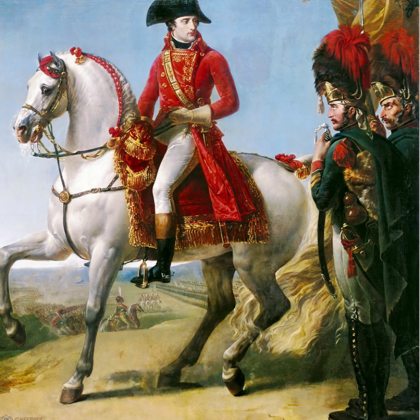NAPOLEON BONAPARTE,THE EMPEROR OF FRANCE(1769 - 1821).WHO CONQUERED OF EUROPE IN THE EARLY 19TH CENTURY.FROM 1802 UNTIL HIS EXILE IN 1815,NAPOLEON EMBARKED ON SEVERAL MASSIVE CAMPAIGN ACROSS VIRTUALLY ALL OF EUROPE.
 Napoleon has been called the "French Revolution on Horseback," a title which has considerable validity if his actions and his program are considered.his conquests did help to spread the ideas of the revolution. Instead of
making Europe into a French Empire he sparked nationalist feeling all
across Europe. He was the cause of the abolition of the tottering Holy
Roman Empire which eventually assisted in the creation of a new Germany.
His impacts all over Europe as well as across the Atlantic could cause
him to be considered as the "revolution on horseback."
Napoleon has been called the "French Revolution on Horseback," a title which has considerable validity if his actions and his program are considered.his conquests did help to spread the ideas of the revolution. Instead of
making Europe into a French Empire he sparked nationalist feeling all
across Europe. He was the cause of the abolition of the tottering Holy
Roman Empire which eventually assisted in the creation of a new Germany.
His impacts all over Europe as well as across the Atlantic could cause
him to be considered as the "revolution on horseback."
Napoleon Bonaparte , also known as Napoleon I, was a French military leader and emperor who conquered much of Europe in the early 19th century. He was born Napoleone di Buonaparte in Corsica, to a relatively modest family from the minor nobility. When the Revolution broke out in 1789, Napoleon was serving as an artillery officer in the French army. Seizing the new opportunities presented by the Revolution, he rapidly rose through the ranks of the military, becoming a general at age 24. The Directory eventually gave him command of the Army of Italy after he suppressed a revolt against the government from royalist insurgents. At age 26, he began his first military campaign against the Austrians and their Italian allies winning virtually every battle, conquering the Italian Peninsula in a year, and becoming a national hero. In 1798, he led a military expedition to Egypt that served as a springboard to political power. He engineered a coup in November 1799 and became First Consul of the Republic. His ambition and public approval inspired him to go further, and in 1804 he became the first Emperor of the French. Intractable differences with the British meant that the French were facing a Third Coalition by 1805. Napoleon shattered this coalition with decisive victories in the Ulm Campaign and a historic triumph over Russia and Austria at the Battle of Austerlitz, which led to the elimination of the thousand-year-old Holy Roman Empire.The victory of the French army over the Russians at Friedland, on the 14 of June, 1807, decided the fate of the fourth coalition. Peace negotiations had begun. In a conversation with Tsar Alexander¹s representative, prince Lobanov-Rostovsky, on the eve of the Tilsit negotiations, Napoleon declared that the mutual interests of Russia and France dictated the necessity of an alliance between these two powers and underscored that the Vistula river must become a genuine and natural frontier of Russia.4 In this way, Napoleon already outlined in this conversation his program of a peace treaty and alliance with Russia, an idea that he contemplated for sometime which was based on a partition of continental Europe between France and Russia. There was no room left for other independent powers in Europe. And there was no room left for the Polish problem either. The territory of Poland was automatically divided along the Vistula between the two allies. A very simple program, quite advantageous to Napoleon as he was to become the master of all Western and Central Europe. One of the most important elements of this program was to weaken Prussia, and to turn it into a country that had no serious role to play on the political arena.The Russian emperor could not accept such a division of Europe. His aim was to preserve as much as possible the balance of power in Europe that existed before the war, and to preserve the old system of alliances, and for that it was paramount to keep Prussia as a more or less strong independent nation. With regard to the fate of the Polish lands, as we see it, neither the French side nor the Russian had any concrete plan. In any case, there is no single document extant to outline either on the French or the Russian diplomatic side the possible resolution of the Polish question, on the eve of the Tilsit negotiations. It was an open field for bargaining.Alexander the 1st could not accept the proposal to partition Europe at the Vistula precisely because it called for the destruction of Prussia as a strong and independent country. At Tilsit, in essence, was to be decided not the question of the Polish Nation, but the question of whose political orbit a given territory was to fall into, how it was to be organized and to what degree this was acceptable to either side. At the same time, both sides could not fail to take into account that on the Polish territory occupied by the French there was a Polish administration and a rather numerous army already in place and actually functioning. To our way of thinking, there has not been due attention given in historic literature to the fact that about this time, Poland had already become a real political power which could not fail to play a significant role in this complicated and strained setting. This factor, of course, was not large enough to bring about the rebirth of independent Poland, but we cannot fail to take it into account.The Tilsit treaty of 1807 declared the creation of the Duchy of Warsaw from "provinces that were part of Prussia" and their switch into "complete ownership and possession of his royal highness, the king of Saxony." The creation of the Duchy of Warsaw undoubtedly gave some advantages to Napoleon. He received the means to exert pressure on Russia, Austria and Prussia and to keep them within the confines of the Tilsit treaty. The creation of this Duchy appeared to the Poles to signal the beginning of the rebirth of the Polish nation, which tied them further to the French Emperor and made them into a weapon in his hands. The king of Saxony receiving now the title of "grand Duke of Warsaw" was an ally and a vassal of Napoleon. Thus France acquired a vassal territory which could become the advance post for a new military campaign. The creation of the grand Duchy of Warsaw did not resolve the Polish problem - it was a temporary, shaky structure, of the same sort that had arisen several times during that tumultuous epoch. Besides, the Tilsit peace treaty itself was not very stable a structure and encompassed within itself almost all the elements of a future war. The international situation in Eastern Europe brought about the Tilsit treaty could not be stable and the creation of the new Duchy of Warsaw was only one of the elements in this instability. The peace treaty had not solved the Polish problem. However in order to prop up the alliance with Russia and assure its participation in the continental system, the French Emperor continued to avoid any kind of promises and declarations regarding the Polish question. It was not due to chance that the newly formed government entity received the title of Duchy of Warsaw, which, according to the French historian A. Vandal, contained "neither recollections nor promises. In 1806, the Fourth Coalition took up arms against him because Prussia became worried about growing French influence on the continent. Napoleon quickly defeated Prussia at the battles of Jena and Auerstedt, then marched the Grand Army deep into Eastern Europe and annihilated the Russians in June 1807 at the Battle of Friedland."However, given the military conflict that was looming with Russia, Napoleon did not want to and could not lose the advantages that the Polish territories could bring him. Moreover, already by the end of 1811, Napoleon was thinking how to best put to use the patriotic feelings of the Poles. In a letter to his step-son dated December 30, 1811, he referred to for the first time in a demagogic way to the new aggression being prepared, as "the Polish War.France then forced the defeated nations of the Fourth Coalition to sign the Treaties of Tilsit in July 1807, bringing an uneasy peace to the continent. Tilsit signified the high watermark of the French Empire. In 1809, the Austrians and the British challenged the French again during the War of the Fifth Coalition, but Napoleon solidified his grip over Europe after triumphing at the Battle of Wagram in July.
 Battle of the Pyramids, also called Battle of Embabeh, (July 21, 1798), military engagement in which Napoleon Bonaparte and his French troops captured Cairo. His victory was attributed to the implementation of his one significant tactical innovation, the massive divisional square.
Battle of the Pyramids, also called Battle of Embabeh, (July 21, 1798), military engagement in which Napoleon Bonaparte and his French troops captured Cairo. His victory was attributed to the implementation of his one significant tactical innovation, the massive divisional square.
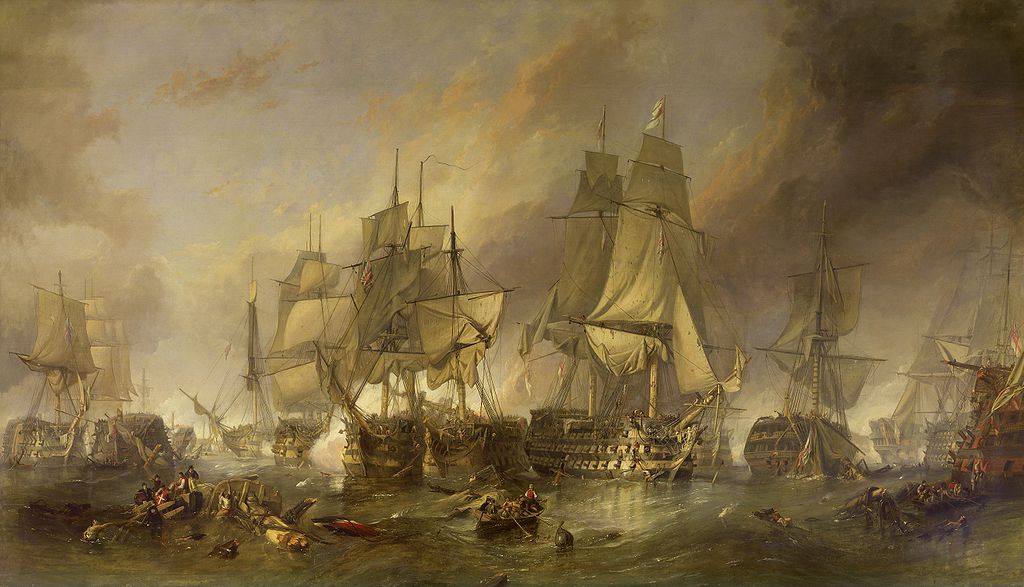
 Napoleonic War England,between 1803 and 1815, Battle of Trafalgar,Battle of Waterloo,Great Britain was the most constant of Napoleon's enemies. Through its command of the sea, subsidies to allies on the European mainland, and active military intervention in the Peninsular War, Britain played the central role in Napoleon's downfall even as all the other major powers switched back and forth.
Napoleonic War England,between 1803 and 1815, Battle of Trafalgar,Battle of Waterloo,Great Britain was the most constant of Napoleon's enemies. Through its command of the sea, subsidies to allies on the European mainland, and active military intervention in the Peninsular War, Britain played the central role in Napoleon's downfall even as all the other major powers switched back and forth.
Napoleonic return from Elba during the Hundred Days. It's the stuff legends are made of - returning to Paris from exile with a thousand soldiers when all the armies of Europe are against him and retaking Paris without firing a shot! This return to power was unprecedented in history and hasn't been repeated since.The brig Inconstant, with Napoleon on board and accompanied by a small flotilla of six ships, departed at nine o’clock from the island of Elba. Profiting by the British commissioner Neil Campbell’s absence, Napoleon was able to escape, accompanied by his soldiers. ‘Paris or death!’ cried the grenadiers, once they were told on board The Inconstant that they were headed for France.Napoleon disembarked in Golfe-Juan, between Cannes and Antibes, on the French Riviera, with a total force of 1,142 men and 2 light cannon. He was about to embark on the most fascinating endeavour in history. 'After the fall of Paris, my heart was torn apart but my spirit remained resolute. Frenchmen, in my exile I heard your complaints and wishes. So, amid all sorts of dangers, I arrived among you to regain my rights, which are yours,'he stated in his proclamation. Napoleon's triumphant return was made possible by the support he still enjoyed in France, from soldiers who wanted to return to glory and full pay, peasants who feared the return of feudal dues, land owners who didn't want to lose their property to nobles and the Church, and imperial civil servants who lost their jobs to the royalists. Napoleon would march to Paris via what is now known as Route Napoleon, a road that was inaugurated by the French government in 1932. It runs from the French Riviera along the foothills of the Alps, marked by impressive stone Imperial Eagles.On the eve of, and in the period of the war of 1812 with Russia, the Duchy of Warsaw became a military bastion of France, and the 100,000 Polish Army fought bravely for his interests. The Poles waited, as the French Resident reported from Warsaw, for the moment when Napoleon would pronounce "the sacred word - Poland." However, he never uttered this word.The Polish problem acquired a special significance during the time of Napoleonic wars, when the map of Europe was rearranged several times and international relations were extremely brittle and unsettled. The geographical location of Polish lands, their strategic significance and political role which an independent Poland might be called to play - all this was taken into account by European powers, and first of all by France in the framework of military and political conflicts of the early 19th century.The Polish questions was not the key problem in the external political activity of the Napoleonic government, but it attracted Napoleon Bonaparte¹s attention as early as the end of the 18th century and during the period of 1806-1812 with the expansion of the French Empire to the East, the role of the Polish problem in France¹s external affairs and diplomacy was already quite significant. It is typical that the two main military campaigns which first foreshadowed the culmination of the might of Napoleon's Empire in 1807 and then the beginning of its demise in 1812 were demographically referred to by Napoleon as the first and second "Polish War."
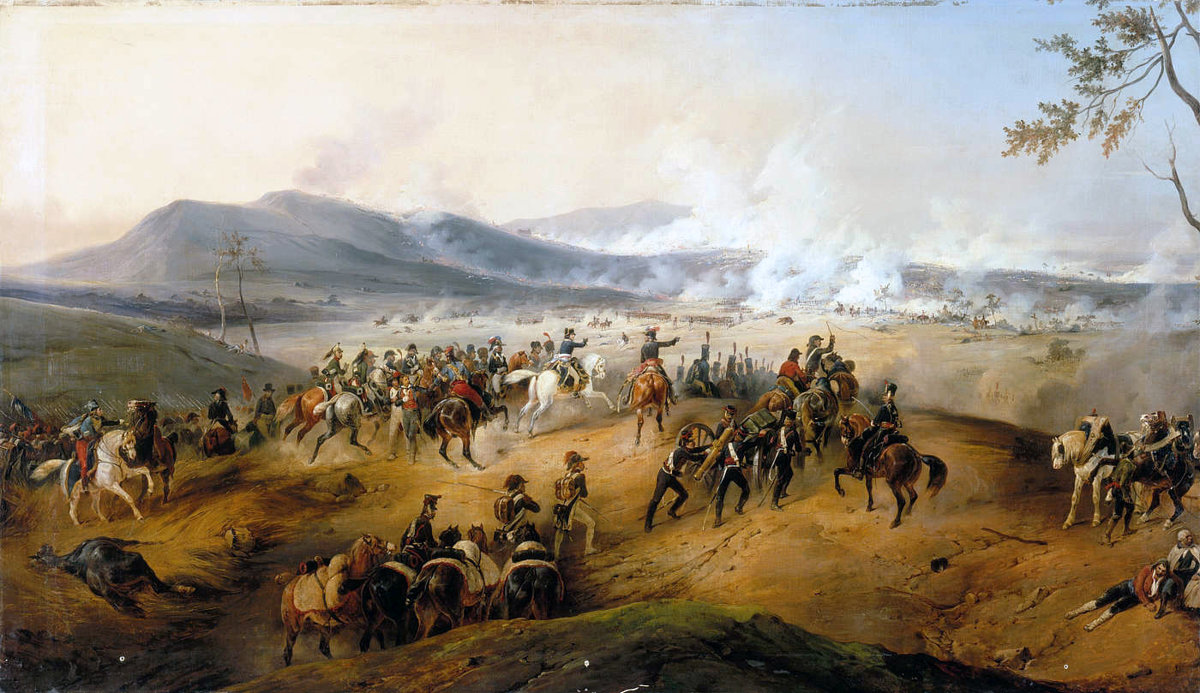 The Battle of Castiglione saw the French Army of Italy under General Napoleon Bonaparte attack an army of Habsburg Austria led by Feldmarschall Dagobert Sigmund von Wurmser on 5 August 1796. The outnumbered Austrians were defeated and driven back along a line of hills to the river crossing at Borghetto, where they retired beyond the Mincio River. The town of Castiglione delle Stiviere is located 10 kilometres (6 mi) south of Lake Garda in northern Italy. This battle was one of four famous victories won by Bonaparte during the War of the First Coalition, part of the Wars of the French Revolution. The others were Bassano, Arcole, and Rivoli.
The Battle of Castiglione saw the French Army of Italy under General Napoleon Bonaparte attack an army of Habsburg Austria led by Feldmarschall Dagobert Sigmund von Wurmser on 5 August 1796. The outnumbered Austrians were defeated and driven back along a line of hills to the river crossing at Borghetto, where they retired beyond the Mincio River. The town of Castiglione delle Stiviere is located 10 kilometres (6 mi) south of Lake Garda in northern Italy. This battle was one of four famous victories won by Bonaparte during the War of the First Coalition, part of the Wars of the French Revolution. The others were Bassano, Arcole, and Rivoli.
In Vienna, Kutuzov’s corps commander, Bagration, paid Murat back for the Danube bridges incident. The formidable position of Hollabrünn, which Murat and Lannes, already held, was on the road he was to use to flee towards the bulk of the Russian forces. The crafty Bagration introduced himself to Murat and tricked him into thinking that Napoleon and Alexander had just signed an armistice. Despite Lannes’ skepticism, Murat, the man who had been standing in Bagration’s shoes just a few days earlier, fell for the ploy. By the time the French realized they had been duped, it was too late. The fighting that ensued at Hollabrünn to make up for the blunder was particularly fierce and costly.The war of 1809 between France and Austria, which ended in a new complete rout of the latter, brought about certain changes in the approach of Napoleon¹s government towards the Polish problem. During the course of the France-Austrian war, there arose a real crisis in the relations between France and Russia, and therefore in the whole system of international politics created by the Tilsit accord - and as a result the enlargement of the territory of the Duchy of Warsaw at the expense of Western Galicia which had been apportioned to Austria during the former partition of Poland. On the eve of the Schoenbrunn peace treaty, the French Foreign Minister, Champagny, wrote to Napoleon: "Poland will begin its rebirth, all the course of the Vistula river will belong to the Duchy of Warsaw, both Polish capitals will be Polish again. Time will bring about the rest." Champagny sketched this way, of course still in vague terms, a plan to create Poland a vassal state (no longer a small duchy) as a weapon of war in the event of a military conflict with Russia.The Franco-Austrian war thus became the boundary line in the approach to the Polish problem by Napoleon's government. The unfolding of events in military action, the successes of Polish troops in Galicia and the obvious passivity of the Russian army convinced Napoleon that his plan to turn Russia into an obedient defender of his interests had failed - and forced him to seek a new resolution to the Polish problem.In 1810, it was becoming apparent that the Tilsit system had outlived its course and that a new European war may ignite precisely in Eastern Europe. The French government began, apparently right after the war of 1809, to work out the details of a new course of their international policy and received a completed sketch of it in the report from Champagny "A view of continental affairs and the rapprochement between Russia and great Britain" presented to Napoleon on March 16, 1810. The main idea of this report came down to this, that the alliance with Russia has entered its last phase - and that war was inevitable. In this sketch Champagny felt that Poland was one of the most faithful allies of France. Therefore in this report a premise was brought forth that it is imperative to unite all the portions of Poland and make it possible to create on the Vistula "an opposing barrier" against Russia. At the same time Champagny felt that Poland itself should be used as a link in the traditional bloc for French external policy - Turkey, Sweden, Poland. This report sketched out in essence a program of diplomatic preparations for the war, in which the question regarding Poland was spelled out very broadly. From the most important moves of the French government, we must highlight the attempt to bring the Duchy of Warsaw into the system of European alliances directed against Russia. On April 24, 1810, Napoleon approved Champagny's decision to send to the French representative in Copenhagen, Didelot, a secret letter outlining the intention of the French emperor to create a secret alliance between Sweden, Denmark and the Duchy of Warsaw. Champagny wrote to Didelot in this regard: "Sweden already fears Russia. Does Denmark experience the same fear? Common interests must force Sweden, Denmark and the Duchy of Warsaw to unite in a secret alliance, which can absolutely and really be guaranteed by France." At the same time, he rushed to add "all this is no more than plans." M. Oginsky, an important Polish magnate living in Paris until 1811, has very accurately noted in his memoirs the true character of Napoleon's plans in this regard. He wrote: "that the French emperor was striving to create a Northern confederation, similar to the Rhine Confederation, of which he wanted to become also her protectorThe most exciting moment happened on 7 March 1815 when Napoleon encountered soldiers of the 5th, who were sent by Louis XVIII to capture him. They caught up to him a few hundred yards south of the town of Laffrey, on what today is known as La Prairie de la Rencontre. For Napoleon, it was the moment of truth. It was his first encounter with the French army since he left Elba. Would they support him? Were they still loyal to him, like they were loyal at Austerlitz, at Wagram, at Marengo? He was about to find out.The commander ordered the troops to fire on Napoleon but no one did. Standing within musket shot, Napoleon opened his iconic overcoat and addressed the troops: 'Soldiers of the 5th! I’ve come back to see you. Do some of you want to kill me?' The troops threw down their muskets and embraced their Emperor. This incident demonstrated Napoleon's incredible bravery, since a single shot from a royalist officer could have brought everything to an end.
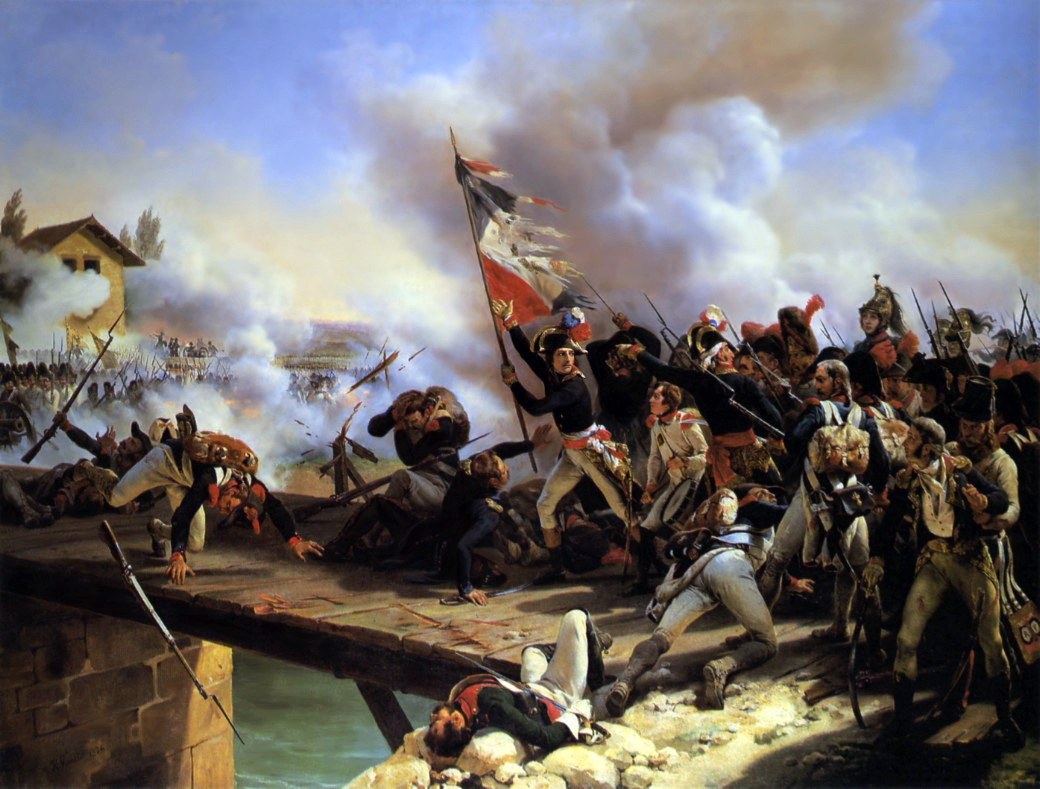 The Battle of Arcole or Battle of Arcola (15–17 November 1796) was a battle fought between French and Austrian forces 25 kilometres (16 mi) southeast of Verona during the War of the First Coalition, a part of the French Revolutionary Wars.The battle saw a bold maneuver by Napoleon Bonaparte's French Army of Italy to outflank the Austrian army led by József Alvinczi and cut off its line of retreat. The French victory proved to be a highly significant event during the third Austrian attempt to lift the Siege of Mantua.
The Battle of Arcole or Battle of Arcola (15–17 November 1796) was a battle fought between French and Austrian forces 25 kilometres (16 mi) southeast of Verona during the War of the First Coalition, a part of the French Revolutionary Wars.The battle saw a bold maneuver by Napoleon Bonaparte's French Army of Italy to outflank the Austrian army led by József Alvinczi and cut off its line of retreat. The French victory proved to be a highly significant event during the third Austrian attempt to lift the Siege of Mantua.
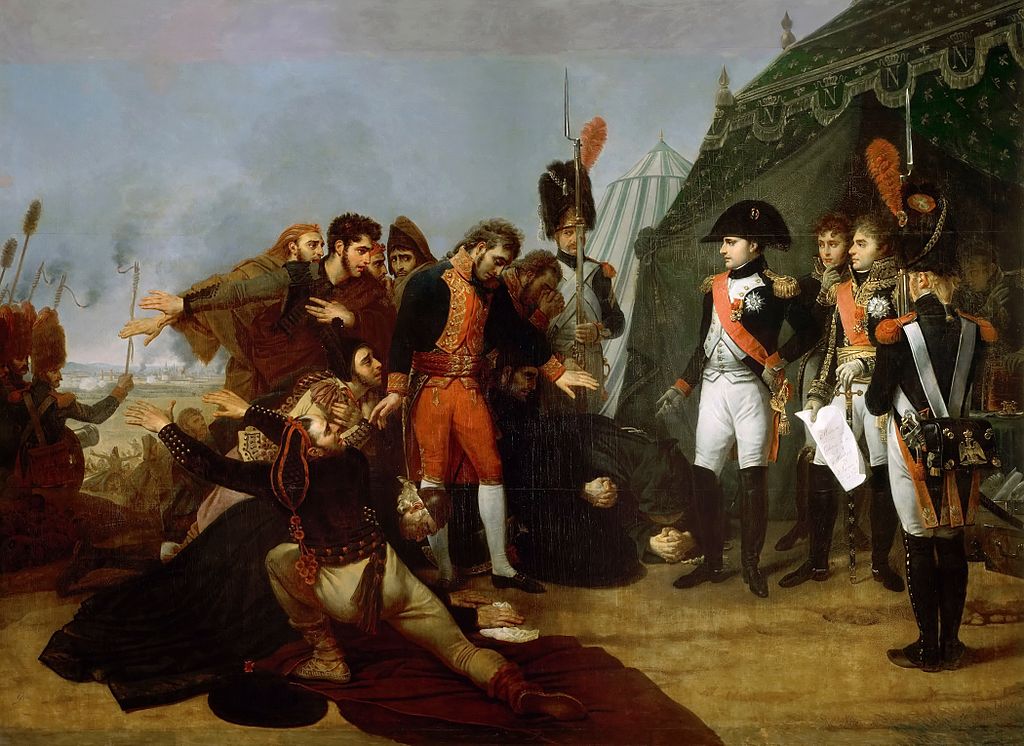
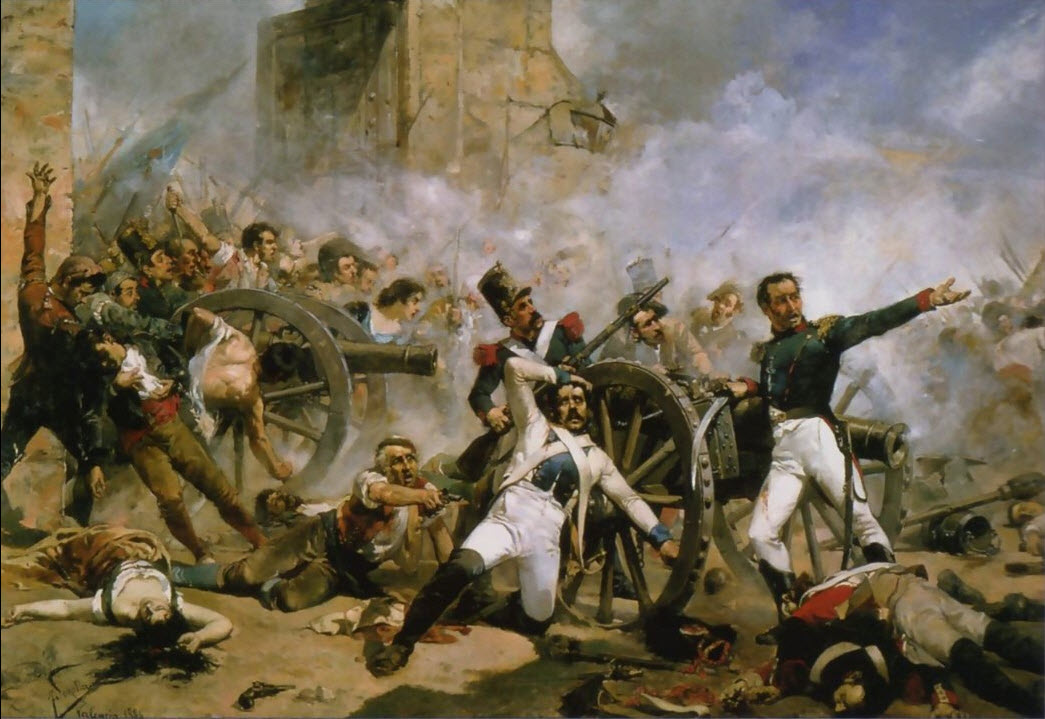 The
siege of Madrid was the final French success during Napoleon’s only
campaign in Spain. Having successfully defeated the Spanish armies on
the Ebro at the battles of Gamonel, 10 November 1808 and of Tudela, 23
November 1808, and Blake’s army in northern Spain at Zornoza 31 October
1808 and Espinosa de los Monteros, 10 November 1808, the French were
free to advance on Madrid. After brushing aside the last line of Spanish
resistance at the Somosierra Pass on 30 November 1808, the first French
troops arrived outside Madrid on December 1.
The
siege of Madrid was the final French success during Napoleon’s only
campaign in Spain. Having successfully defeated the Spanish armies on
the Ebro at the battles of Gamonel, 10 November 1808 and of Tudela, 23
November 1808, and Blake’s army in northern Spain at Zornoza 31 October
1808 and Espinosa de los Monteros, 10 November 1808, the French were
free to advance on Madrid. After brushing aside the last line of Spanish
resistance at the Somosierra Pass on 30 November 1808, the first French
troops arrived outside Madrid on December 1.
